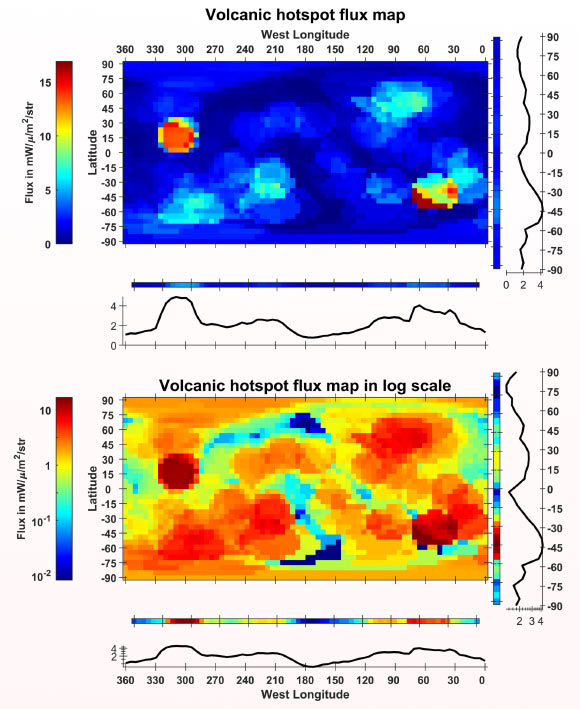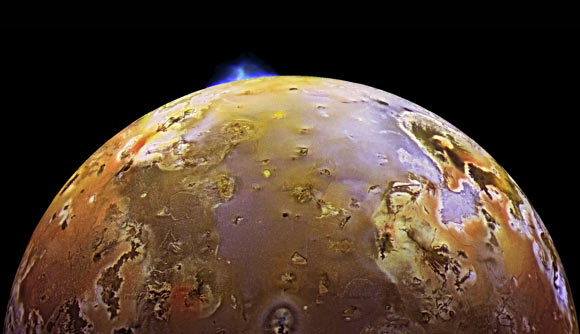
Io is the most volcanically active body in the Solar System. Io’s volcanoes are powered by both the extreme tides from Jupiter and the gravitational interactions between it and Jupiter’s other moons. These tides generate friction inside Io. Using data from an infrared camera on NASA’s Juno orbiter called the Jovian Infrared Auroral Mapper (JIRAM), planetary researchers at Cornell University have mapped where Io’s volcanoes are producing the most power and compared that to where scientists expect higher heat flow from the interior models. They found that Io has active volcanoes at its poles that may help to regulate tidal heating in its magma interior.

These are maps of the global volcanic flux on Io in an equirectangular projection, showing the averaged volcanic flux in milliwatts per square meter per steradian (the most common units for volcanic flux on Io). The top is on a linear scale while the bottom is on a logarithmic color scale. The colored bars and the line plots beside each map show the average flux projected horizontally (to the right of each map) and the average flux projected vertically (below each map) to show trends in flux by latitude and longitude. Image credit: Pettine et al., doi: 10.1029/2023GL105782.
Io, the innermost Galilean moon of Jupiter and the most volcanically active body in the Solar System, is a unique resource for studying volcanism outside Earth and tidally-generated volcanism.
Despite its importance in the development of the worlds of the outer Solar System (and beyond), tidal heating remains relatively unconstrained.
In fact, the existence of volcanism powered entirely through extreme tidal forces and strong orbital resonances was only proposed and discovered in the last five decades.
“Tidal heating plays an important role in the heating and orbital evolution of celestial bodies,” said Cornell University’s Professor Alex Hayes.
“It provides the warmth necessary to form and sustain subsurface oceans in the moons around giant planets like Jupiter and Saturn.”
“Studying the inhospitable landscape of Io’s volcanoes actually inspires science to look for life,” said Madeline Pettine, a doctoral student at Cornell University.
By examining the JIRAM data from 11 Juno orbits, the authors found that Io has active volcanoes at its poles that may help to regulate tidal heating in its magma interior.
“I’m trying to match the pattern of volcanoes on Io and the heat flow that they’re producing with the heat flow we expected from theoretical models,” Pettine said.

This image from NASA’s Galileo spacecraft shows a volcanic explosion on Io. Image credit: NASA / JPL / University of Arizon.
Using a mathematical equation called spherical harmonic decomposition, a way of understanding round objects, the researchers broke down Juno’s flyby maps to establish complex volcanic surface patterns.
They found a surprising number of active volcanoes at Io’s poles, as opposed to the more-common equatorial regions.
“I’m not solving tidal heating with this one paper. However, if you think about icy moons in the outer Solar System, other moons like Jupiter’s Europa, or Saturn’s Titan and Enceladus, they’re the places that if we’re going to find life in the Solar System, it will be one of those places,” Pettine said.
“The interior liquid water oceans in the icy moons may be kept liquefied by tidal heating.”
“We need to know how the heat is being generated. It’s easier to study tidal heating on a volcanic world rather than peering through a kilometers-thick ice shell that’s keeping the heat covered up.”
According to the scientists, both pole regions of Io have active volcanoes.
In the north, a cluster of four volcanoes — Asis, Zal, Tonatiuh, one unnamed and an independent one named Loki — were highly active and persistent with a long history of space mission and ground-based observations.
A southern group, the volcanoes Kanehekili, Uta and Laki-Oi demonstrated strong activity.
The long-lived quartet of northern volcanoes concurrently became bright and seemed to respond to one another.
“They all got bright and then dim at a comparable pace,” Pettine said.
“It’s interesting to see volcanoes and seeing how they respond to each other.”
The study was published in the journal Geophysical Research Letters.
_____
M. Pettine et al. 2024. JIRAM Observations of Volcanic Flux on Io: Distribution and Comparison to Tidal Heat Flow Models. Geophysical Research Letters 51 (17): e2023GL105782; doi: 10.1029/2023GL105782
 Print
Print


